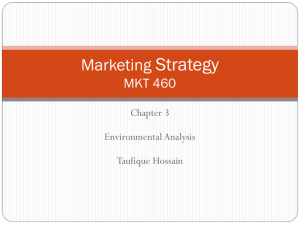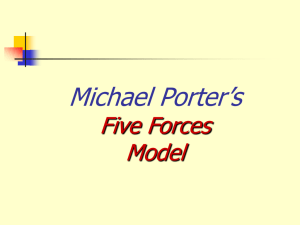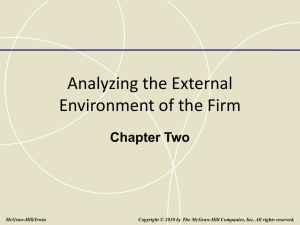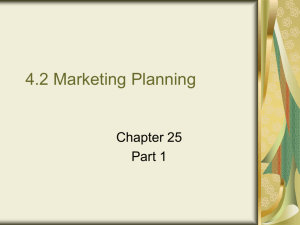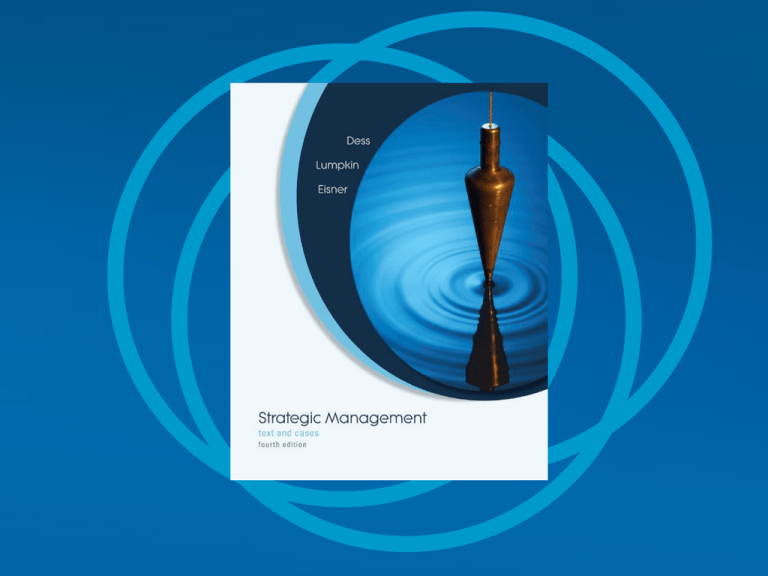
2
Analyzing the External
Environment of the Firm
McGraw-Hill/Irwin
Strategic Management: Text and Cases, 4e
Copyright © 2008 The McGraw-Hill Companies, Inc. All rights reserved.
2- 3
Learning Objectives
After reading this chapter, you should have a good
understanding of:
-
-
The importance of developing forecasts of the
business environment.
Why environmental scanning, environmental
monitoring, and collecting competitive intelligence
are critical inputs to forecasting.
Why scenario planning is a useful technique for
firms competing in industries characterized by
unpredictability and change.
The impact of the general environment on a firm’s
strategies and performance.
2- 4
Learning Objectives
After reading this chapter, you should have a good
understanding of:
-
-
-
-
How forces in the competitive environment can affect
profitability and how a firm can improve its competitive
position by increasing its power vis-à-vis these forces.
How trends and events in the general environment and
forces in the competitive environment are interrelated
and affect performance.
How the internet and digitally based compatibilities are
affecting the five competitive forces and industry
profitability.
The concept of strategic groups and their strategy and
performance implications.
2- 5
Purpose of External Environmental
Analysis
• Organizations are affected by
conditions in the environment
• Managers need to be aware of these
conditions in order to
- Take advantage of opportunities
that can lead to higher profits
- Reduce the impact of threats that
can harm the organization’s future
2- 6
Creating the Environmentally
Aware Organization
Managers need information in order to know and
develop an understanding about what is happening
in the external environment
2- 7
Environmental Scanning & Monitoring
• External Scanning
- Surveillance of a firm’s external environment:
• Predict environmental changes to come
• Detect changes already under way
• Proactive mode
• External Monitoring
- Track evolution of:
• Environmental trends
• Sequence of events
• Streams of activities
2- 8
Competitive Intelligence
• Define and understand a firm’s industry
• Identify rivals’ strengths and weaknesses
- Intelligence gathering (data)
- Interpretation of intelligence data
• Helps a firm avoid surprises
2- 9
What Competitive Intelligence
Is and Is Not
Competitive Intelligence Is …
1. Information that has
been analyzed to the
point where you can
make a decision.
2. A tool to alert
management to early
recognition of both
threats and opportunities.
3. A means to deliver
reasonable
assessments.
4. A way of life, a process.
Competitive Intelligence Is Not
…
1. Spying. Spying implies
illegal or unethical activities.
It is a rare activity.
2. A crystal ball. Competitive
Intelligence is good
approximation of reality; it
does not predict the future.
3. Database search. Data by
itself is not good intelligence.
4. A job for one smart
person.
Adapted from Exhibit 2.2 What Competitive Intelligence Is and Is Not!
2- 10
Environmental Forecasting
• Plausible projections about
-
Direction of environmental change
Scope of environmental change
Speed of environmental change
Intensity of environmental change
• Scenario analysis
2- 11
Question
Which of the following is a danger of forecasting?
a) Managers assume that the world is not open to
precise predictions.
b) Managers may view uncertainty as black and white
and ignore grey areas.
c) Managers assume that the world is uncertain.
d) Managers view the world as completely
unpredictable.
2- 12
SWOT Analysis
• Managers need to analyze
- The general environment
- The firm’s industry and competitive advantage
• SWOT analysis
-
Strengths
Weaknesses
Opportunities
Threats
Basic technique for analyzing firm and industry
condition
2- 13
Example
• Harley Davidson SWOT
- Strengths
• Strong & adaptable brand image
- Weaknesses
• Limited ability to develop new non-traditional products
- Opportunities
• Growing leisure interest in motorcycles worldwide
- Threats
• Differing foreign policies governing motorcycles
Source: Developed from www.harley-davidson.com
2- 14
The General and Competitive Environment
General Environment
Demographics
Competitive
Global
Political/Legal
Environment
Threat on new entrants
Bargaining power of suppliers
Bargaining power of buyers
Threat of substitute products
Sociocultural
Competitive rivalry
Macoreconomic
Technological
2- 15
The General Environment
• Segments of the general environment
include:
-
Demographic
Sociocultural
Legal/Political
Technological
Economic
Global
• General environmental trends and
events:
- Little ability to predict them
- Even less ability to control them
- Can vary across industries
General
Environment
2- 16
Demographic Segment
• Aging population
• Rising affluence
• Changes in ethnic composition
• Geographic distribution of population
• Greater disparities in income levels
2- 17
Sociocultural Segment
• More women in the workforce
• Increase in temporary workers
• Greater concern for fitness
• Greater concern for environment
• Postponement of family formation
2- 18
Political/Legal Segment
• Tort reform
• Americans with Disabilities Act (ADA)
• Repeal of Glass-Steagall Act in 1999
• Deregulation of utility and other industries
• Increases in federally mandated minimum wages
• Taxation at local, state, federal levels
• Legislation on corporate governance reforms
(Sarbanes-Oxley Act)
2- 19
Technological Segment
• Genetic engineering
• Emergence of Internet technology
• Computer-aided design/computer-aided
manufacturing systems (CAD/CAM)
• Research in synthetic and exotic materials
• Pollution/global warming
• Miniaturization of computing technologies
• Wireless communication
• Nanotechnology
2- 20
Economic Segment
• Interest rates
• Unemployment
• Consumer Price index
• Trends in GDP
• Changes in stock market valuations
• Financial industry reform
2- 21
Global Segment
• Increasing global trade
• Currency exchange rates
• Emergence of the Indian and Chinese economies
• Trade agreements among regional blocs
(NAFTA, EU, ASEAN)
• Creation of WTO (decreasing tariffs/free trade in
services)
2- 22
The Competitive Environment
• Segments of the competitive
environment include:
- Competitors
- Customers
- Suppliers
• Sometimes called the task or
industry environment
• Porter’s five forces model
Competitive
Environment
2- 23
Competitive Environment
• The essence of strategy formulation is coping with competition.
• The corporate strategists’ goal is to find a position in the
industry where his or her company can best defend itself
against these forces or can influence them in its favor.
• Managers must understand the conditions of competition within
their industry
- Porter Five-Forces Model of Competition (determining the
attractiveness of an industry)
- Strategic Groups
- Key Success Factors
- Competitive Changes During industry Evolution
- National Competitive Advantage (Chapter 7)
2- 24
Porter’s Five Forces Model
of Industry Competition
2- 25
Example
• Porter’s Five Forces Model: BMW
- Threat of new entrants
• Very low
- Threat of substitutes
• Medium
- Power of suppliers
• Medium
- Power of buyers
• Medium
- Rivalry among existing firms
• Very High
Source: Developed from www.bmw.com
2- 26
The Threat of New Entrants
• Fundamental question: how easy is it for another
company to enter the industry?
• Profits of established firms in the industry may be eroded
by new competitors
• High entry barriers lead to low threat of new entries
- Economies of scale
- Product differentiation
- Capital requirements
- Switching costs
- Access to distribution channels
- Cost disadvantages independent of scale
2- 27
Question
If you are considering opening a new café in your
community, what would be the threat of new
entrants? How would you evaluate Porter’s other
forces for this industry? Explain.
2- 28
The Bargaining Power of Buyers
Fundamental questions: How badly does a
buyer need your products or services?
Buyers threaten an industry
- Force down prices
- Bargain for higher quality or more services
- Play competitors against each other
2- 29
The Bargaining Power of Buyers
• A buyer group is powerful when
- It is concentrated or purchases large volumes relative
to seller sales
- The products it purchases from the industry are
standard or undifferentiated
- The buyer faces few switching costs
- It earns low profits
- The buyers pose a credible threat of backward
integration
- The industry’s product is unimportant to the quality of
the buyer’s products or services
2- 30
The Bargaining Power of Suppliers
Fundamental question: how badly does a
supplier need your business?
• Suppliers can exert power by threatening to raise prices
or reduce the quality of purchased goods and services
• A supplier group will be powerful when
- The supplier group is dominated by a few companies and
is more concentrated than the industry it sells to
- The supplier group is not obliged to contend with substitute
products for sale to the industry
- The industry is not an important customer of the supplier
group
2- 31
The Bargaining Power of Suppliers
• A supplier group will be powerful when (cont.)
- The supplier’s product is an important input to the
buyer’s business
- The supplier group’s products are differentiated or it
has built up switching costs for the buyer
- The supplier group poses a credible threat of forward
integration
2- 32
The Threat of Substitute
Products and Services
Fundamental question: what other products or
services could perform the same function as
your products or services?
• Substitutes limit the potential returns of an
industry
- Ceiling on the prices that firms in that industry can
profitably charge
- Price/performance ratio
2- 33
The Intensity of Rivalry among
Competitors in an Industry
Fundamental question: how intense is
competition in the industry?
•
•
•
•
•
•
Jockeying for position
Price competition
Advertising battles
Product introductions
Increased customer service or warranties
Interacting factors lead to intense rivalry
- Numerous or equally balanced competitors
- Slow industry growth
- High fixed or shortage costs
- Lack of differentiation or switching costs
- Capacity augmented in large increments
- High exit barriers
2- 34
How the Internet and Digital
Technologies Influences Industry
2- 35
The Value Net
2- 36
A Sixth Force: Complementors
• Not a supplier
• Offers service or product that affects industry’s
performance
• When complementors are important and their number
is increasing
- Demand and profits in the industry are boosted
• When complementors are weak
- Industry growth can slow and profits can be limited
• Example: Internet Service Providers “complementors”
to eBusiness firms
2- 37
Using Industry Analyses: A Few Caveats
• Five Forces analysis implicitly assumes a zerosum game
• Five Forces analysis is essentially a static
analysis
- Value net
• Suppliers and customers (the vertical net)
• Substitutes and complements (the horizontal net)
2- 38
Strategic Implications of the
Five Competitive Forces
• Competitive environment is unattractive
from the standpoint of earning good
profits when:
– Rivalry is strong
– Entry barriers are low and entry is likely
– Competition from substitutes is strong
– Suppliers and customers have considerable
bargaining power
2- 39
Strategic Implications of the
Five Competitive Forces
• Competitive environment is ideal
from a profit-making standpoint when:
– Rivalry is moderate
– Entry barriers are high and no firm is
likely to enter
– Good substitutes do not exist
– Suppliers and customers are in a weak
bargaining position
2- 40
Strategic Groups within Industries
• Two unassailable assumptions in industry
analysis
- No two firms are totally different
- No two firms are exactly the same
• Strategic groups
• Cluster of firms that share similar strategies
-
Breadth of product and geographic scope
Price/quality
Degree of vertical integration
Type of distribution system
2- 41
Strategic Groups within Industries
• Value of strategic groups as an analytical tool
- Identify barriers to mobility that protect a group from
attacks by other groups
- Identify groups whose competitive position may be
marginal or tenuous
- Chart the future direction of firms’ strategies
- Thinking through the implications of each industry
trend for the strategic group as a whole
2- 42
Strategic Groups
• Companies do not compete against all companies in
an industry
• Companies compete against several other companies
that follow similar strategies
• A strategic group consists of those rivals with similar
competitive approaches in an industry
• Examples ways of competing:
- Price
-- Range of products
- Innovation
-- Customers served
- Research
- Quality
2- 43
Procedure for Constructing a
Strategic Group Map
STEP 1: Identify competitive characteristics that differentiate firms in an
industry from one another
STEP 2: Plot firms on a two-variable map using pairs of these
differentiating characteristics
STEP 3: Assign firms that fall in about the same strategy space to same
strategic group
STEP 4: Draw circles around each group, making circles proportional to
size of group’s respective share of total industry sales
2- 44
Types of Video Game
Suppliers/Distribution Channels
Example: Strategic Group Map of the
Video Game Industry
Arcades
Arcade
operators
Publishers
of games on
CD-ROMs
Home PCs
Sony, Sega,
Nintendo, several
others
Video game
consoles
MSN Gaming Zone,
Pogo.com,
America Online,
HEAT, Engage,
Oceanline, TEN
Online/Internet
Low
(Coin-operated
equipment)
Medium
(Console players cost
$100-$300)
High
(Use PC)
Overall Cost to Players of Video Games
2- 45
Key Success Factors
• In many industries, there are certain actions or
practices that a business must follow in order to
compete in the industry.
• May need effort to distinguish company from
competitors
• AN INDIVIDUAL COMPANY DOES NOT HAVE KEY
SUCCESS FACTORS!!!!
• KEY SUCCESS FACTORS ARE NOT THE SOURCE
OF A COMPANY’S COMPETITIVE ADVANTAGE –
THEY ARE REQUIREMENTS FOR COMPETING IN
AN INDUSTRY AND DO NOT GIVE ANY FIRM A
COMPETITIVE ADVANTAGE
2- 46
Examples of Key Success Factors in
Selected Industries
•
•
•
•
Pharmaceuticals: research and personal selling
Beer: advertising and distribution
Restaurant: quality food, service, location, notoriety
Retailer: location and priced-for-quality
2- 47
Changes in Competition During
Industry’s Evolution
• Over time as an industry evolves, the nature and basis
of competition changes
• Managers must anticipate how the forces will change
as the industry evolves and formulate appropriate
strategies
• Five Stages ( similar to product-life cycle)
- Embryonic—introduction of product
- Growth
- Shakeout
- Mature
- Declining
2- 48
Stages in the Industry Life Cycle
2- 49
Shakeout: Growth in Demand and
Capacity
2- 50
Requirements in Each Stage of
Industry’s Evolution
• Embryonic: Know-how, educating customers, opening
distribution channels
• Growth: Know-how for continued innovation,
financing, build demand
• Shakeout: Dominant market position, low cost
producer, high capacity
• Maturity: low cost production, brand loyalty
• Declining: lowest cost production, reduce capacity
2- 51
Limitations of Models for Industry
Analysis
• Life cycle issues
- The embryonic stage can sometimes be skipped
- Industry growth can be revitalized
- The time span of the stages can vary
• Innovation and change
- Innovation can unfreeze and reshape industry
structure
- An industry may be hypercompetitive, with permanent
and ongoing change
2- 52
Limitations of Models for Industry
Analysis (cont’d)
• Company differences
- The importance of company differences within an industry
or strategic group can be underemphasized
- The individual resources and capabilities of a company
may be more important in determining profitability than the
industry or strategic group

